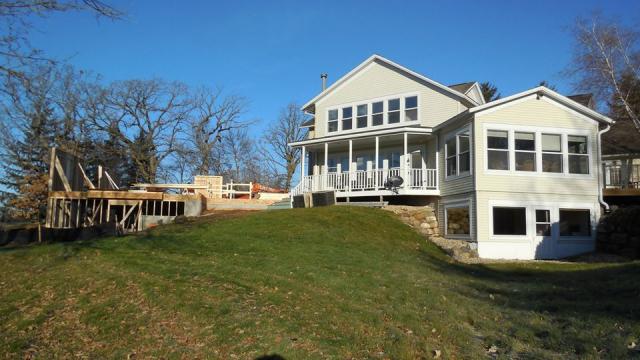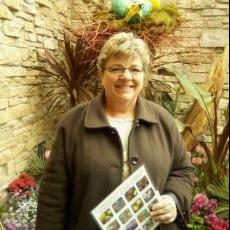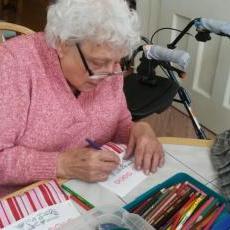






 The second Hope & A Future house under construction (Franco Latona/Madison Commons)
The second Hope & A Future house under construction (Franco Latona/Madison Commons)
Karin Krause has fond childhood memories of sitting on her grandmother's porch, listening to her stories while peeling vegetables for that evening's dinner. Her grandma always had coffee and cookies ready to offer neighbors who frequently stopped by to chat.
After school, Krause worked with an elderly neighbor woman in her garden, where she learned how to grow tomato plants. The woman always wore a pioneer bonnet that Krause liked very much. One day in the garden, she remembers her eight-year-old self asking “when you die, can I have that hat?” It was not until about 30 years later–long after the two had lost touch–that Krause's mother said she had a strange item to give to her: the hat. The woman had specifically included it in her will.
“I burst out in tears,” Krause said. “It made me think I must have been important to her.”
Today, Krause is founder and director of Hope & A Future, an adult family residence she has run at her home for over a decade. She has her eye on expansion, with the goal of building a supportive intergenerational community on the Far West Side.
Krause believes connections between the generations, particularly old and young, make everyone’s life richer. Barbara Bowers, professor and assistant dean of research at the UW-Madison School of Nursing, said that sentiment is supported by research.
“In general, there is pretty good evidence that interacting with — not just young people — but across generations is beneficial for [everyone],” she said.
Hope & A Future currently houses four senior citizens—all female—as well as one single mother and her two children. Because four senior residents live in the home, Hope & A Future is not considered a “Community-Based Residential Facility” under state law (the minimum is five). Therefore, it is not held to the same regulations as conventional nursing homes.
 Karin Krause, founder of Hope & A Future, believed many residents in nursing homes were missing community. (Franco Latona/Madison Commons)Krause said this distinction is critical because it enables residents to live a “normal life.” They are free to help with daily tasks like cooking and cleaning, and can go anywhere in the house without supervision. Each senior has her own room; the mother and children share two bedrooms. Additionally, two certified nursing assistants live at Hope & A Future, and Krause's daughter, Ruth, works there as an art therapist.
Karin Krause, founder of Hope & A Future, believed many residents in nursing homes were missing community. (Franco Latona/Madison Commons)Krause said this distinction is critical because it enables residents to live a “normal life.” They are free to help with daily tasks like cooking and cleaning, and can go anywhere in the house without supervision. Each senior has her own room; the mother and children share two bedrooms. Additionally, two certified nursing assistants live at Hope & A Future, and Krause's daughter, Ruth, works there as an art therapist.
Krause graduated from the UW-Madison School of Nursing in the 1970s, which she attended because she wanted to work with older people. After taking a job in a nursing home, she soon became discouraged. She felt her training was insufficient, and because of high resident-to-staff ratios, Krause said she never could spend quality time with residents. At one point, Krause worked 3 p.m. to 11 p.m. shifts, but constantly found herself leaving after 2 a.m. So she asked one of her coworkers how she always managed to leave on time.“Karin, you can't talk to these people and get off on time,” Krause recalled her response.
Krause found that many of her patients were lonely despite living in what should have been a community. She concluded that it resulted from a lack of normal interaction. Residents did not participate in activities with one another where conversation occurs naturally.
After spending about 20 years employed in various roles at nursing homes, Krause decided to quit and instead take an elderly woman named Elizabeth Sewell (wife of William H. Sewell, former UW-Madison Sociology Professor and Chancellor) into her home. Sewell was completely dependent on care, so Krause, with a husband and three daughters, worried about the impact on her family. Her fears quickly diminished, however, as the entire family warmed to Sewell immediately.
“I thought, 'I love this,'” she said.
Krause said one day she asked William Sewell what he missed about being younger. Sewell said as a professor he hosted gatherings with colleagues and teaching assistants where people brought their families, food and instruments; a time to bond with one another. Krause liked the idea and began holding regular gatherings in her home.
People of all different ages and backgrounds attended the parties, Krause said. She recalled one night a teenager with a blue mohawk and facial piercings knocked at the door. “Can I help you?” Krause said. He said he had heard about a party at her home. Krause said that was true, but was puzzled as to whether or not he understood what kind of party he was attending. She explained there were no drugs or alcohol in the house. The teenager said he knew that, and wanted to come in anyways. Krause asked him his reason for coming, and he said he heard there was great conversation, music and food at the parties. Krause welcomed him inside.
 Margaret Hall is a resident of Hope & A Future and enjoys making salads for the two youngest residents. (Franco Latona/Madison Commons)She said the parties reinforced her belief that people of different age groups should communicate regularly. That is the guiding principle of Hope & A Future. In fact, she still holds parties on the second Friday of every month.
Margaret Hall is a resident of Hope & A Future and enjoys making salads for the two youngest residents. (Franco Latona/Madison Commons)She said the parties reinforced her belief that people of different age groups should communicate regularly. That is the guiding principle of Hope & A Future. In fact, she still holds parties on the second Friday of every month.
Rosemarie Lasecki moved into Hope & A Future about seven months ago. She frequents the Middleton library with other residents and staff, and enjoys reading her books on the back patio. She also takes piano lessons from Krause's daughter, Ruth. The food—all three meals are prepared daily by Hope & A Future staff—is not bad either, Rosemary said, “as long as we don't have too many casseroles.”
Margaret Hall was born in Oxford, England, but came over to the United States with her American husband (who was in England on Air Force duty) in 1952. She worked for many years as a welder at a factory in Verona, and has now lived with Krause for almost five years. Hall said she enjoys making salads for the youngest of the two girls in the home because she knows all of the different vegetables she likes.
Hope & A Future added an addition to the home about a year ago, thanks in large part to volunteer help from members of High Point Church. Bill Perkins, who had been advising Krause on affordable housing for almost a decade, led the construction crews. The addition gave Krause the space to house the current residents, and saved a significant amount of money, she said.
The next two stages—with stage one now complete—are in the early phases of development. The original plan was to build a number of individual condos on the property, which would be rented or sold to seniors and young families. But they ran into conflict with the city of Madison.
The city wanted Hope & A Future to build a road through the property along with the housing. Krause said a road would interfere with the natural landscape and increase the number of condos in order to pay for it. She said the construction would leave very little natural landscape on the property, too.
So it is back to the drawing board. Krause said she is considering building one multi-unit condo on the northeast corner of the property. Seniors and young families will be able to rent or buy units, based on their ability to pay. The condo will include a community room, too, where residents can come to converse and participate in activities. Krause said having one unit will enable Hope & A Future to maintain much of its natural landscape, where residents can walk and expand on gardens.
The two demographics will be mutually beneficial to one another, Krause said. Young families can aid senior citizens with physical tasks, and seniors can serve as mentors for young families. Seniors who purchase the condos will not need full-time care, but Hope & A Future will provide health services when needed. Krause hopes that the community room will be a place where residents come to work on arts and crafts, woodworking and other activities where conversation and relationships develop naturally.
Despite the obstacles, Krause maintains her passion for intergenerational housing and cultivating community. She still remembers one of the stories her grandmother told her out on the front porch one day.
While sitting there, Krause said her grandmother told her to look at all of the irises in the yards of her neighbors and take notice of the different colors and patterns, except for one neighbor, whose irises had all turned white. Krause's grandmother explained that every year the neighbors dig up their irises and exchange bulbs so that their plants become more colorful and diverse. But that one neighbor refused to participate; she said her irises were a better quality.
“That's what happens when you don't mix with people,” her grandmother said.
|
|
|
Welcome to the Madison Commons, a website designed to provide news and information about all of Madison's neighborhoods and a crossroads for the discussion of community issues. The name comes from the idea of a village commons, a place for news, talk, debate, and some entertainment, too, that's open to everyone.
All rights reserved. Read more about the Madison Commons and its partners.

